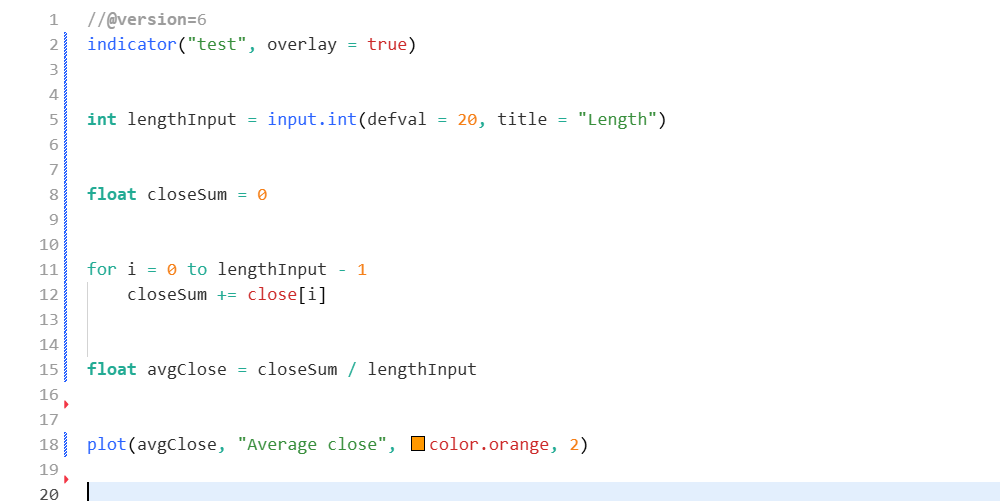交易术语表A - B - C - D - E - F - G - H - I - J - K - L - M - N - O - P - Q - R - S - T - U - V - W - X - Y - Z-HHandle 大数在交易中,术语“大数”有两种含义,具体取决于不同市场。在大多数市场中,大数是完整报价中小数点左侧的部分。在外汇中,它指的是买入价和卖出价中看到的部分报价。Hawks and doves 鹰派和鸽派鹰派和鸽派是分析师和交易员用来对中央银行委员会成员投票和决定货币政策之前进行分类的术语。Hedge/Hedging 对冲对冲是一种旨在降低现有风险敞口的投资或交易。通过投资降低风险的过程称为“对冲”。Heikin Ashi 平均K线图平均K线图是一种用于技术分析的图表模式。 平均K线图表类似于蜡烛线,但主要区别在于平均K线图图表使用每日价格均值来显示资产的中值价格的变动。High frequency trading 高频交易高频交易平台 (HFT)是一种使用强大的计算技术快速处理大量交易的高级交易平台。它既可以用于为单个大订单寻找最佳价格,也可以用于在市场中实时寻找获利机会。
H

Related Articles

交易术语表A - B - C - D - E - F - G - H - I - J - K - L - M - N - O - P - Q - R - S - T - U - V - W - X - Y - Z-EEarnings per share 每股收益 每股收益 (EPS) 是一家公司的净利润除以已发行股票的数量。是一种通常用于衡量公司盈利能力的工具。 EBITDA 息税折旧摊销前利润息税折旧摊销前利润(扣除利息、所得税、折旧、摊销之前的利润)是一种评估公司业绩的方式。净收入的替代衡量标准。 ECB 欧洲央行欧洲央行代表欧洲中央银行,是欧元区的中央银行。Equity 权益权益在交易中可以有多种不同的含义,但它通常指的是没有任何债务的资产的所有权。Equity options 股票期权股票期权是赋予持有人权利(而非义务)的合同,可以在到期日之前以指定价格买卖标的证券的股票。 ETF 交易所交易基金ETF代表交易所交易基金,是一种在证券交易所交易的基金。 ETP 交易平台 ETP 代表交易所交易产品,是在证券交易所公开交易的金融产品类型。Eurobond 欧洲债券欧洲债券是以本国货币(发行市场或国家)以外的货币计价的债务产品。有时称为外部债券。 Eurodollar Bonds 欧洲美元债券欧洲债券的一种,欧洲美元债券以美元计价,但在美国境外出售。可以销往世界各地。Exotics 奇异货币奇异货币是指交易不太活跃的货币。Exchange 交易所交易金融产品的开放市场。交易所也被称作“市场”。Execution 执行由经纪人执行和完成的来自交易员的订单买卖。Expiry date 到期日交易头寸自动平仓的那一天。Expiry 到期(期货合约)期货合约的到期日是您可以交易该合约的最后一天。 Exposure 风险敞口风险敞口可能是在交易中会发生的任何事。它可以是投资于某种资产的资金数额,也可以是投资者未平仓交易的总市值。或是任何特定时间段内潜在的风险总量。

交易术语表A - B - C - D - E - F - G - H - I - J - K - L - M - N - O - P - Q - R - S - T - U - V - W - X - Y - Z-CCable 电缆外汇中的电缆是英镑/美元货币对的别称,是市场上最受欢迎的货币对之一。 Calendar Spread 日历价差日历价差是一种交易技术,它包括在一个月内购买一项资产的衍生品,并在另一个月出售同一资产的衍生品。日历价差代表同一资产从一种期货合约到另一种期货合约的价格差异。 Call option 看涨期权看涨期权是在特定日期之前以给定价格购买资产的期权。Capital expenditure 资本支出花费在有形资产的资金。 Capital gains 资本收益资本收益是当资产的售价超过原始购买价时,从资产买卖中获得的利润。Capital gains tax 资产增值税资产增值税(或 CGT)是政府对出售的任意金融资产所得利润征收的税。 Capital loss 资本损失与资本增值相反。指当资产的售价低于持有者用于购买该资产的原始成本。 Cash flow 现金流现金流是公司资金流入和流出的数量,以及由此产生的可用现金。它可以是单个项目或整个企业的。Cash Price 现金价格不要与即时价格或现货价格混淆,现金价格是指为立即交付的商品或资产而支付或收取的价格。越接近现货期货合约的到期日,现货价格和现货期货价格应该越接近。Cash rate 现金利率现金利率也称为银行利率或基准利率,是中央银行向其他银行贷款收取的利率。 Chartist 图表交易员图表交易员主要依靠图表来帮助他们理解历史数据,以便更好地推测未来的价格走势。也通常被称为技术分析师或技术交易员。Closing price 收盘价交易日结束时金融市场上证券的价格。收盘价可以用作在查看长期历史走势时的标记,或与开盘价进行比较,以回顾一天内的走势。 Commission 佣金佣金是投资经纪人代表客户进行交易而收取的服务费。 Commodity 大宗商品大宗商品是一种可以买卖的基础实物资产。通常是用于生产其他商品或服务的原材料中的一类。Contracts for difference 差价合约差价合约 (CFD) 是一种金融衍生品,其收益或损失基于合约开仓和平仓时的资产价格差异。这是一种以现金结算开盘价和收盘价之间的价格差额,并且没有实物商品或证券交付的结算方案。Contract (Lot)成交单位(手数) 手数是一个交易单位,代表固定数量的特定资产。外汇市场的标准手数为 100,000 美元。一迷你手为 10,000 美元。Convexity 凸性债券凸性是衡量债券价格和债券收益率之间“曲线程度”或差异的指标。它是一种风险管理工具,用于评估利率上升或下降可能对债券价格产生的影响——这突出了债券持有人的风险敞口。Contango 期货溢价通常在市场供应充足时看到,期货溢价是指商品或证券的期货价格高于现货价格(现价)。此时可以通过预计较高的期货合约价格以反映商品的持有成本。Cost of carry 持有成本持有成本是持有头寸所需的额外资金数额。这可能包括隔夜融资费用、利息费用或在交割期货合约时存储任意大宗商品的成本。这些费用是交易时的重要考虑因素,因为它们会影响净回报。 Covered call 备兑看涨期权备兑看涨期权是一种看涨期权交易策略,即持有可交易资产的现有多头头寸,并针对同一资产出售(卖出)看涨期权以产生额外收入。目的是增加交易者可获得的整体利润。CPI 消费者物价指数 CPI代表消费者物价指数,衡量美国消费者每月支付的平均价格的变化。 Crystallisation 结晶交易结晶交易是通过卖出头寸并立即重新开仓来获得盈利或产生亏损的行为。 Currency appreciation 货币升值一种货币相对于另一种货币的增值。外汇交易中一种货币的“走强”意味着购买它会花费更多,或者它可以在卖出时购买更多的另一种货币。Currency depreciation 货币贬值在浮动汇率制度中,一种特定货币相对于另一种货币的贬值。在浮动汇率制度中,一种货币的价值根据外汇市场的供需关系决定。Currency peg 货币挂钩一种货币的固定汇率,由国家政府或中央银行设定。有时也被称为固定汇率或“挂钩”。Currency Swap 货币互换有时又称为交叉货币互换,这是一种两方之间以两种不同货币的本金和固定利率利息支付交换为双方商定的交换汇率的协议。

交易术语表A - B - C - D - E - F - G - H - I - J - K - L - M - N - O - P - Q - R - S - T - U - V - W - X - Y - Z-DDark pools 暗池暗池是一个私人组织的金融论坛或证券交易场所。它们允许机构投资者在交易执行和报告之后进行无风险交易。Day order 当日指令当日指令是指向经纪人发出的以特定价格执行交易的订单准备金,该指令在交易日结束时到期。Day trading 日内交易日内交易涉及在收市前买卖股票,以赚取短期利润。Debt ratio 资产负债率资产负债率用于与资产价值对比以表明公司持有多少债务。它也可以应用于个人:即为个人债务的应计费用与每年总收入的比值。Delta 德尔塔值德尔塔值也被称为对冲比率,是期权交易中使用的一种衡量标准,用于评估期权合约的价格如何随着标的资产价格的变动而变化。Depreciation 贬值一件资产价值的下降被定义为贬值。它可能由市场环境或其他因素造成,如磨损和折旧。与升值相反。Derivative 衍生品衍生品是从标的资产的价格中获取价值的金融产品。交易员经常使用衍生品作为一种工具来推测资产的未来价格走势,无论是上涨还是下跌,都无需购买资产本身。Direct market access (DMA) 直接市场准入 (DMA) 直接市场准入 (DMA) 是一种将交易直接放置在交易所订单簿上的方式。因此,直接市场准入在交易时为交易者提供了灵活性和透明度。但由于其中的风险和复杂性,通常仅建高阶交易员使用。Dividend 股息企业选择按百分比返还给股东的一部分利润称为股息。股息通常每季度支付一次,但在某些情况下,也会每年甚至每月支付一次,具体取决于公司政策。
Recent Articles
.jpg)
一、全球及澳大利亚金融状况概览:
在本次会议上,委员们回顾了全球及澳大利亚的金融状况。近期全球科技股估值过高引发市场波动,股票价格一度下跌后反弹,美国市场受预期宽松货币政策支撑,而澳大利亚股市下跌持续更久,反映市场对现金利率上升和部分板块估值调整。全球债市利差仍低,但部分国家公司债收益率上升。利率预期方面,美联储预计降息并延续宽松,欧洲央行维持利率,加拿大、新西兰、瑞典和澳大利亚可能上调,日本则在通胀压力下逐步加息。澳大利亚短期债券收益率上升,但澳元仅小幅升值,缓解金融紧缩压力。国内方面,抵押贷款支出高企,家庭储蓄率维持高位,信贷需求回升,企业债务占GDP比重恢复至疫情前水平,显示金融状况喜忧参半。
二、经济增长与通胀趋势:
委员们对国内经济增长与通胀趋势进行了评估。10月年度CPI升至3.8%,部分因电费补贴停止,新房成本、市场服务、耐用品及国内旅行价格均高于预期,短期通胀前景上行风险增加,但数据波动性较大,需继续观察。劳动力市场方面,失业率上升趋势已在10月得到控制,其他未充分利用劳动力指标维持低水平,企业招聘仍有困难,但工资价格指数总体稳定,公共部门工资增长抵消私营部门放缓,整体略显紧张。经济增长方面,截至9月季度GDP增速接近潜在水平,私人需求增长强劲,数据中心和住房投资为主要动力,宽松政策效果预计在2026年显现。产出缺口为正,NAB产能利用率指标显示产能约束高于历史平均水平,表明经济存在一定需求过剩。
三、货币政策考量与决策
在政策讨论中,委员们重点关注三方面:总需求略高于潜在供给,通胀风险上升但持续性仍不明;私人需求复苏将支撑劳动力需求,经济增长动力依然存在;金融环境信号分化,部分委员认为不再紧缩,部分认为仍略紧,需观察债券收益率及利率上升影响。近期CPI及成本端指标显示通胀压力上行,但短期内过度推断趋势存在风险。若通胀持续上行,未来一年可能需加息,但仍需评估金融环境和市场利率对经济的作用。本次会议决定维持现金利率目标3.60%不变,并强调将持续密切关注数据变化及经济前景,在未来会议评估政策调整必要性。董事会重申其使命,致力实现价格稳定和充分就业,并将采取一切必要措施达成目标。
总结:
本次RBA会议表示,金融状况信号分化,利率上升与汇率变动影响尚未完全显现;通胀压力上行但短期持续性不明;劳动力市场略紧,私人需求复苏支撑经济。政策暂按兵不动,未来可能加息,重点关注2026年初通胀数据及金融市场动态。
.jpg)
TradingView编程系列5:循环结构(上)
循环(Loops) 是一种结构,它会根据指定的条件反复执行一段语句块。它们允许脚本在不需要重复编写代码的情况下完成重复性的任务。Pine Script提供了三种不同的循环类型:for、while 和 for…in。
一、隐式循环
Pine Script的执行模型和时间序列结构,使得在许多情况下并不需要写出明显的循环。
当用户将一个 Pine 脚本添加到图表中时,脚本会在一个等同于“大循环”的环境中运行:它会在可用数据中的每一根历史 K 线以及每一个实时 tick 上各执行一次代码。脚本可以通过历史引用运算符(history-referencing operator)访问之前 K 线上的执行结果;而通过使用 var 或 varip 关键字声明的变量,其计算结果可以在多次执行之间保持不变。这些特性使脚本能够通过逐 K 线(bar-by-bar)的计算来完成各种任务,而无需依赖显式的循环。
下面我们来看一个简单的示例,说明在 Pine Script 中不必要地使用循环的情况。

下面按逐行解释这段 Pine Script 代码的含义和执行逻辑:
首先,声明这是一个指标脚本(indicator)。test是指标在图表上显示的名称。overlay = true 表示该指标绘制在主价格图表上。
其次,声明一个整数类型变量名为lengthInput的变量。input.int()为创建一个用户可在参数设置中修改的整数输入项,其中默认值为 20 根 K 线。在参数面板中显示的名称为length。
接下来,再声明一个初始化变量为 0,浮点数类型的变量closeSum。注意,由于没有使用 var 关键字,在每一根 K 线上脚本执行时,closeSum 都会被重新置为 0。
然后进入for循环,对最近的 lengthInput 根 K 线进行循环,将每根 K 线的收盘价累加到 closeSum。在循环体中,把最近 lengthInput 根 K 线的收盘价逐一相加。
再之后,用收盘价总和除以 K 线数量,计算平均值,保存到变量avgClose中。
最后,将数据画成线,其中"Average close"为图例名称,线条颜色为橙色,线条宽度为2。
总结来说,这段代码就是用for循环计算并绘制最近 lengthInput 根 K 线的收盘价平均值。
其实,这个示例的重点在于演示 “不必要的循环”,在 Pine Script 中,这种均值计算可以直接使用内置函数ta.sma,例如:
avgClose = ta.sma(close, lengthInput)
二、显性循环
尽管 Pine 的执行模型、时间序列结构以及可用的内置函数在许多情况下都能消除对循环的需求,但并非所有迭代任务都可以不用循环。在以下几类任务中,循环是必不可少的:
- 遍历或操作集合(如数组、矩阵和映射)
- 执行无法通过无循环表达式或现有内置函数完成的计算
- 回溯历史数据以分析过去的 K 线,而比较所需的参考值仅在当前 K 线上才可用
例如,要判断哪些过去的 K 线的最高价(high)高于当前 K 线的最高价,就必须使用循环。
这是因为:当前 K 线的数值在脚本运行于之前的历史 K 线时是无法获取的。脚本只能在执行到当前 K 线时访问该 K 线的数值,并且必须在这次执行过程中向后回溯历史序列,将之前的数值与当前值进行比较。
例如,下面的脚本使用 for 循环,将之前 lengthInput 根 K 线的最高价与最后一根历史 K 线的最高价进行比较。在循环中,它调用 label.new(),在每一根最高价高于最后一根历史 K 线最高价的过去 K 线上方绘制一个圆形标签:

首先,声明这是一个名为test2的指标脚本。此脚本允许最多绘制 500 个label,否则在绘制大量标签时会触发限制错误。然后设置lengthInput变量,该变量表示要拿多少根过去的 K 线的最高价(high),来和最后一根历史 K 线的最高价比较,1和500为允许输入的最小值和最大值。
接下来,判断当前是否是最后一根已确认的历史 K 线。barstate.islastconfirmedhistory在历史数据的最后一根 K 线时返回 true,在实时 K 线或更早的历史 K 线上返回 false。
在最后一根历史K线的最高价位置画一条水平虚线。其中line.new的前四个参数分别为起点横坐标,起点纵坐标,终点横坐标,终点纵坐标。
接下来进入For循环,首先判断过去某根 K 线的最高价 > 当前(最后历史)K 线的最高价,如果高于,则紫色圆形标签自动绘制在 K 线柱的上方。
最后一行代码,使用三元运算符判断给最后一根历史 K 线上色高亮。如果是最后一根历史 K 线,则为橙色,否则不改变颜色。

可以看到,当我们将长度参数设置为 60 后,图表中会在最高价高于当前 K 线最高价的历史 K 线上方显示紫色圆点,同时还会绘制一条表示当前 K 线最高价的水平虚线,用于直观地标示该参考价位。
综上所述,本文通过示例对比说明了 Pine Script 中“不必要循环”和“必须使用循环”的典型场景。合理理解 Pine 的执行模型,优先使用内置函数,可以提升脚本的简洁性与性能;而在需要基于当前 K 线回溯并分析历史数据时,循环则不可或缺。掌握循环的正确使用方式,有助于编写更高效、清晰且功能强大的 Pine Script 脚本。

What moved the ASX 200 in 2025?
In 2025, the ASX 200 closed around 8,621 points and was up approximately 6% year to date (YTD) as of 19 December close. Market direction was most sensitive to Reserve Bank of Australia (RBA) expectations, commodity prices and China-linked demand, and (to a lesser extent) moves in the Australian dollar (AUD). The index recovered from November’s pullback, but remained below October’s record close.
Key 2025 drivers included:
- RBA policy expectations: Sentiment was shaped by shifting views on the timing and extent of rate moves. The November pullback reflected repricing towards a longer pause and higher uncertainty around whether the next move could be a hike rather than a cut, particularly as jobs and inflation data surprised.
- Resources and China sensitivity: With a meaningful resources weight, the index responded to iron ore stability, strong gold prices and relative firmness in base metals. China data and any perceived policy support (including signals from the People’s Bank of China (PBOC)) remained important for the export backdrop. A relatively stable AUD also reduced currency-related noise for exporters.
- Index composition and market structure: The ASX 200’s heavier tilt to materials and banks, and lower exposure to high-growth technology, meant it often lagged tech-led global rallies, but tended to hold up better when AI and growth valuations were questioned.
- Corporate earnings: Reporting season outcomes influenced valuation support. In September’s half-year reporting season, around 33% of ASX 200 companies beat expectations, which helped underpin pricing around current levels.
Current state
The ASX 200 was roughly 5% below its late-October record high close of 9,094 points. After the November retracement, support around 8,400 appeared to hold and buying interest improved. The 50-day EMA near 8,730 (a prior consolidation area) was a commonly watched near-term reference, noting technical indicators can be unreliable.
What to watch in January
- China and commodity demand: Growth, trade and any fresh stimulus inference from the PBOC may affect sentiment.
- Domestic inflation and labour data: CPI and jobs prints are key inputs into RBA expectations.
- Key levels and follow-through: The post-November rebound may need continued demand to sustain momentum.

What moved the Nikkei 225 in 2025?
In 2025, the Nikkei 225 traded around 39,200 points and was up approximately 21% year to date (YTD). Market direction was most sensitive to moves in the Japanese yen (JPY) and Bank of Japan (BOJ) communication, with the index consolidating after multi-decade highs. While broader signals remained constructive, consolidation can resolve either higher or lower.
Key influences included:
- JPY movements and earnings translation: A weaker JPY can boost the reported value of overseas earnings for some exporters, although it may also increase input and import costs. The net impact often depends on company hedging practices and varies by sector, with effects most evident in export-heavy industries such as automotive, industrials and parts of technology manufacturing.
- Gradual BOJ policy transition: The BOJ continued to step away from ultra-easy settings, but tightening was generally cautious. Markets largely priced a slow, conditional normalisation, which helped limit downside, even as policy headlines created bouts of volatility.
- Corporate governance reforms: Ongoing improvements in capital efficiency and shareholder returns supported interest from overseas investors. Share buybacks, stronger balance-sheet discipline and improved return on equity (ROE) contributed to re-rating in parts of the market.
- Global cyclical exposure: The Nikkei moved with shifts in global manufacturing sentiment and expectations for US growth, particularly during risk-on phases associated with AI-related capital spending.
Current state
After pushing to multi-decade highs earlier in the year, the Nikkei spent time consolidating but has remained structurally strong. Price sits above key long-term moving averages, and some technicians watch the 50-day exponential moving average (EMA) as a potential reference level (noting these indicators can be unreliable). Currency swings and shifting BOJ expectations were commonly cited as contributors to much of the second-half volatility, although pullbacks were generally met with buying interest.
What to watch in January for Japan
- JPY volatility: Sharper yen moves, especially if driven by BOJ or Federal Reserve expectations, could quickly change exporter earnings assumptions.
- BOJ communication: Small changes in language on inflation persistence or bond market operations may move sentiment.
- Global growth data: US and China manufacturing and trade prints remain key inputs for an externally focused economy.



